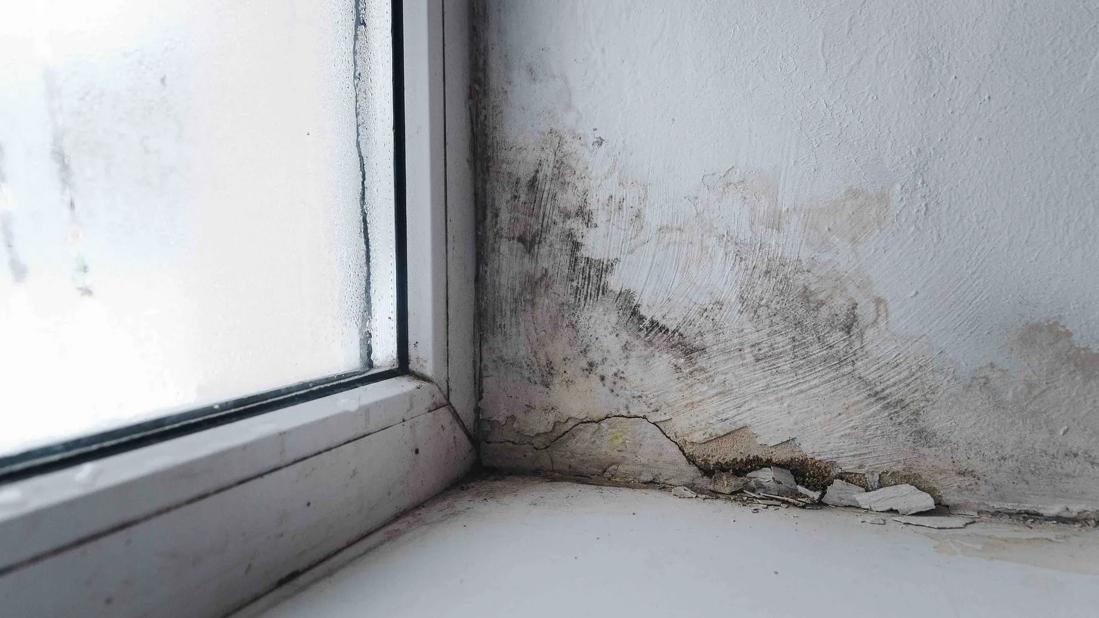Mold exposure can cause allergic reactions, asthma and skin rashes

Mold grows in almost any color, sprouts up year-round and can be found just about anywhere — spotting your shower curtain with fuzzy polka dots, cropping up in corners of your spooky basement and making itself at home in the siding on your house.
Advertisement
Cleveland Clinic is a non-profit academic medical center. Advertising on our site helps support our mission. We do not endorse non-Cleveland Clinic products or services. Policy
This funky fungus grows and thrives in damp, warm, humid places. And it can cause real problems for your health when it does.
Mold spores are teeny-tiny cells that spread through the air. They thrive in warm, damp, humid spots, both outdoors and indoors, especially anywhere affected by water damage (like leaks or flooding). When these spores land on things and start to reproduce, mold begins to grow.
“If you’re exposed to mold, you can develop breathing problems that range from mild to severe,” says critical care pulmonologist Lamia Ibrahim, MD. “To know how to protect yourself, start by knowing where mold spores thrive.”
Dr. Ibrahim shares some locations where mold is common (though this isn’t an exhaustive or complete list) and its potential impact.
“Outside, you’ll find mold in shady, damp areas or where leaves or other vegetation break down,” Dr. Ibrahim says. This includes:
“Inside homes and other buildings, mold grows in high-humidity locations, like basements and showers,” Dr. Ibrahim says, “and especially in areas where poor ventilation prevents water from drying quickly.”
Advertisement
Left a window open in a rainstorm and your carpet got soaked? Leaky toilet trickled through the living room ceiling? Haven’t checked inside your coffeepot since you bought it? Beware the high likelihood of mold.
Bathrooms are a common spot, too, even in the cleanest of homes. Mold can grow out in the open, like on shower curtains, shower walls and in holes in caulk and grout. But it can also lurk out of sight, like beneath loose tiles or in the toilet tank. (Check your toothbrush holder, too!)
Here are other places where mold is common:
This list sounds scary, we know. Like … is mold everywhere?! To some extent, yes: Mold is common, and many types of mold are generally harmless. But molds can also create toxins that can affect your health.
Breathing or touching mold can cause symptoms like allergic reactions, asthma and skin rashes. But which symptoms you experience depends on factors like your overall health, the strength of your immune system, your allergies, etc.
“Not everyone responds to mold exposure the same way,” Dr. Ibrahim clarifies. “Your symptoms may be different from other people’s, and they can range from mild to severe.”
She explains more about the possible symptoms of mold exposure.
Mold spores produce allergens, or substances that can cause allergic reactions. Not everyone is allergic to mold, but if you are, you may experience symptoms like:
If you have a severe mold allergy, you can even develop fever, shortness of breath and anaphylaxis (a life-threatening allergic response).
If mold exposure brings lasting allergic symptoms, you can develop a respiratory infection. Mold spores can also irritate your lungs and cause breathing troubles, even if you’re not allergic to mold.
“When they’re introduced to your body, spores irritate the airways in your nose, mouth and throat,” Dr. Ibrahim explains. This can cause:
Advertisement
“Mold spores can cause burning and bleeding if they become lodged in your mucus membranes, like in your sinuses and lungs,” Dr. Ibrahim warns. This may include:
We’ll talk later about when to see a doctor for mold exposure, but it’s worth noting here: Bleeding symptoms always warrant a conversation with a healthcare provider.
There are some specific conditions associated with mold exposure, like:
Advertisement
If you’re feeling safe because you’ve never had breathing problems in the past, you may want to think again. In reality, mold can be responsible for breathing problems in almost anyone.
“There’s sufficient evidence to link mold exposure with upper respiratory tract symptoms like coughing and wheezing in otherwise healthy people,” Dr. Ibrahim says.
That said, certain conditions can make you more sensitive to mold:
Some people are at higher risk of developing breathing problems related to mold exposure, like:
Advertisement
You’re also more likely to experience symptoms if you live or work somewhere where you’re regularly exposed to mold. But you might not even realize that’s the case.
“Pay close attention to symptoms that are only present or worsen at home or other public areas where mold is common,” Dr. Ibrahim advises.
There’s no way to avoid mold entirely, but it’s best to avoid it as much as you can, especially if you know it gives you trouble.
“If you’re prone to breathing problems like asthma, try to limit your exposure to damp, humid areas like basements and saunas,” Dr. Ibrahim recommends.
To keep yourself and your family healthy, follow these tips for limiting mold exposure.
“For the most part, mold-induced breathing problems are temporary, and symptoms usually fade with less exposure to the fungus,” Dr. Ibrahim says.
But talk to a healthcare provider if you have symptoms of mold exposure, especially if you already have allergies or asthma. If you know you’ve been exposed to mold at home, at work or on a trip, tell them everything you can about the mold and the location.
“Be sure to mention all the symptoms you may have, no matter how trivial they may seem,” she stresses. “When you’re being evaluated for a new problem, there are no insignificant symptoms.”
Learn more about our editorial process.
Advertisement

Drowsiness is a side effect of inflammation, disrupted sleep and, sometimes, your allergy medicine

If you’re sensitive to aspirin or other salicylates, limiting exposure is the best remedy

If allergies have you coughing and sniffling all night, try showering before bed, keeping the windows closed and propping your head up

If allergies make your mornings a slog, consider closing the windows and showering at night

When the trees start to bloom, your allergies can come to life — medications, closing the windows and keeping clean can help

Water, touch, sunlight, physical activity and cold are some of the rarest allergies

Autumn allergens typically begin to bloom — and release their pesky pollen — around August

Babies can get congested easily, but you can calm their cough by keeping them hydrated, using nasal drops and running a humidifier

Weight loss may cause loose, sagging skin and muscle loss to your rear

Several conditions, like vitiligo and fungal infection, can cause a loss of pigmentation, leading to white spots or patches on your skin